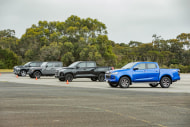
Do you need a dual cab ute?
Everybody seems to think they need a dual-cab, but plenty of people never actually use their twin-cab ute to its full potential
Everybody seems to think they need a dual-cab, plenty of people never actually use their twin-cab ute to its full potential.
Think about it. Are you ever likely to actually have five people on board? And wouldn’t it be useful to have more storage space instead of empty seats?
- Dual cab or double cab utes are practical for people who really need passenger space
- They aren’t as practical if you really need cargo space
- There are single-cab and space-cab alternatives that could be better for your business
There is clearly a category of buyer for whom a dual-cab ute makes a lot of sense - that is someone who is going to use their vehicle, not only for work purposes, but also as a personal transportation device.

If you have a family with one, two or three children, and you don’t want another car, or know you’ll use the ute as a weekend adventure rig for camping, then a double-cab probably is right for you. Just note - double cab models typically only offer two child-seat attachment points. And often, the rigmarole involved in trying to attach and remove those seats means that you’d want them to be there all the time, or never at all.
For instance, some utes require the top-tether for the window seat spots to be attached above the centre position, and it can be difficult to achieve a confidence-inspiring level of strap fastening. The best of the mainstream family utes I’ve experienced when it comes to rear seat space and child-seat friendliness is the GWM Cannon Ute, which has proper dedicated outboard top-tether spots behind each of the window seats (and ISOFIX, too).

Or maybe you know you’ll be on apprentice pick-up and drop-off duties, so you know a dual-cab will allow you to get yourself and your work crew to the job site. My dad bought a dual-cab for that very reason, and even though he uses the back seat maybe only once a month, it proves a handy spot for him to store his painting drop-sheets (they stay dry and neatly folded in the second-row).
But you must also keep in mind that a ute is a ute. Storage space and flexibility is important, that’s what makes a vehicle like this a great tool of trade.
And while rear seat bases that can be folded up to allow a flat, dry storage space is undoubtedly a benefit, you should also consider that dual-cab utes typically cost more.
We’re talking thousands more, in most cases. For a base model ute, you’re looking at a circa-$10,000 gap between an entry-level Navara single-cab and dual-cab, and it’s about the same for a Triton or BT-50, and closer to $13K more for a HiLux to move up from the base cab-chassis single-cab to the dual-cab entry model.

The utes that offer a smaller step up from single- to dual-cab are the Ford Ranger (only about $5000 at base level), and the Isuzu D-Max (around $8000).
Budget is one thing, but the usability of the ute is really going to be the deciding factor for you. If you need a bigger tray, want more space for your work gear, or think you need a lot more toolbox space than you’ll be able to get in a dual-cab, then the better choice will be with a space-cab (aka extra-cab or king-cab), as they offer you about 30cm more tray space but still a bit of secure dry space behind the seats. Or a single-cab, which is definitely the best option if you want a “proper” work truck that is about getting you and your stuff from A to B much more than it is about getting you and other occupants between those points.

The pluses for dual-cab utes, aside from back row space, is that they are more popular, and that means there are literally dozens more options for you to choose from. For instance, here’s a rundown of the best-selling utes and how many different cab derivations they offer:
- Ford Ranger - single-cab: 2; extra-cab: 4; dual-cab: 18
- Toyota HiLux - single-cab: 6; extra-cab: 5; dual-cab: 18
- Isuzu D-Max - single-cab: 6; extra-cab: 4; dual-cab: 17
- Mitsubishi Triton - single-cab: 2; extra-cab: 3; dual-cab: 8
- Nissan Navara - single-cab: 4; extra-cab: 4; dual-cab: 18
In the current iterations (at the time of publishing), these are the utes that are only available in dual-cab design:
- GWM Cannon Ute
- Volkswagen Amarok
- LDV T60
- SsangYong Musso
- Ram 1500
- Jeep Gladiator
- GMSV Chevrolet Silverado
The other thing you might want to note is that many of the dual-cab utes have significantly more optional accessories available, both through the brand’s dealerships, or through the aftermarket. So if you plan to make your rig look and feel like something that represents you, then you ought to consider what you can or can’t get to make it so.
Whether you need a dual-cab could well be determined by your circumstances, but it is interesting to note just how many brands are moving to dual-cab-only line-ups, and even the big sellers are clearly geared more towards the double-cab market.

More Tradie Ute Guide


